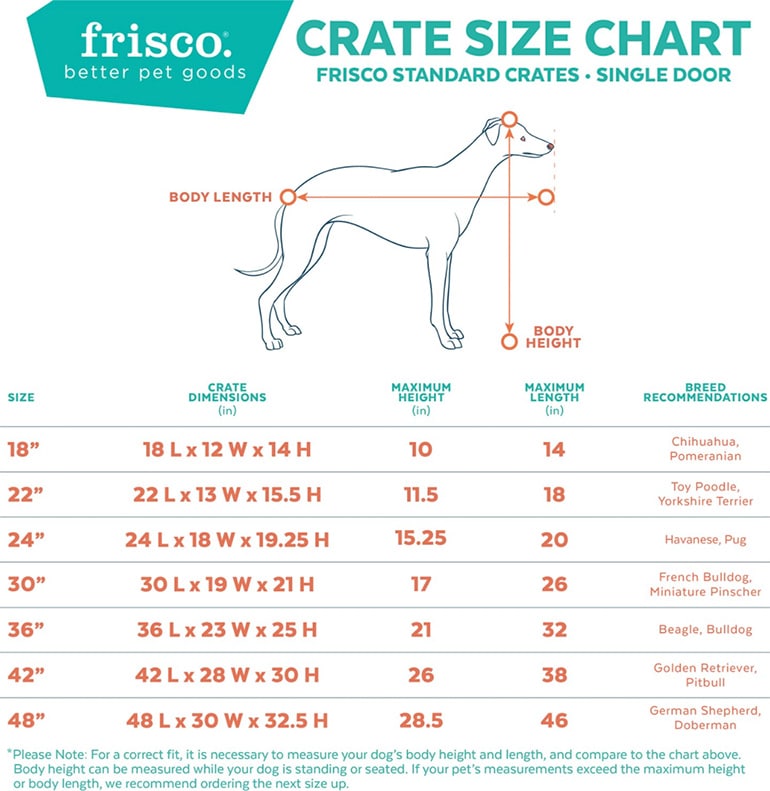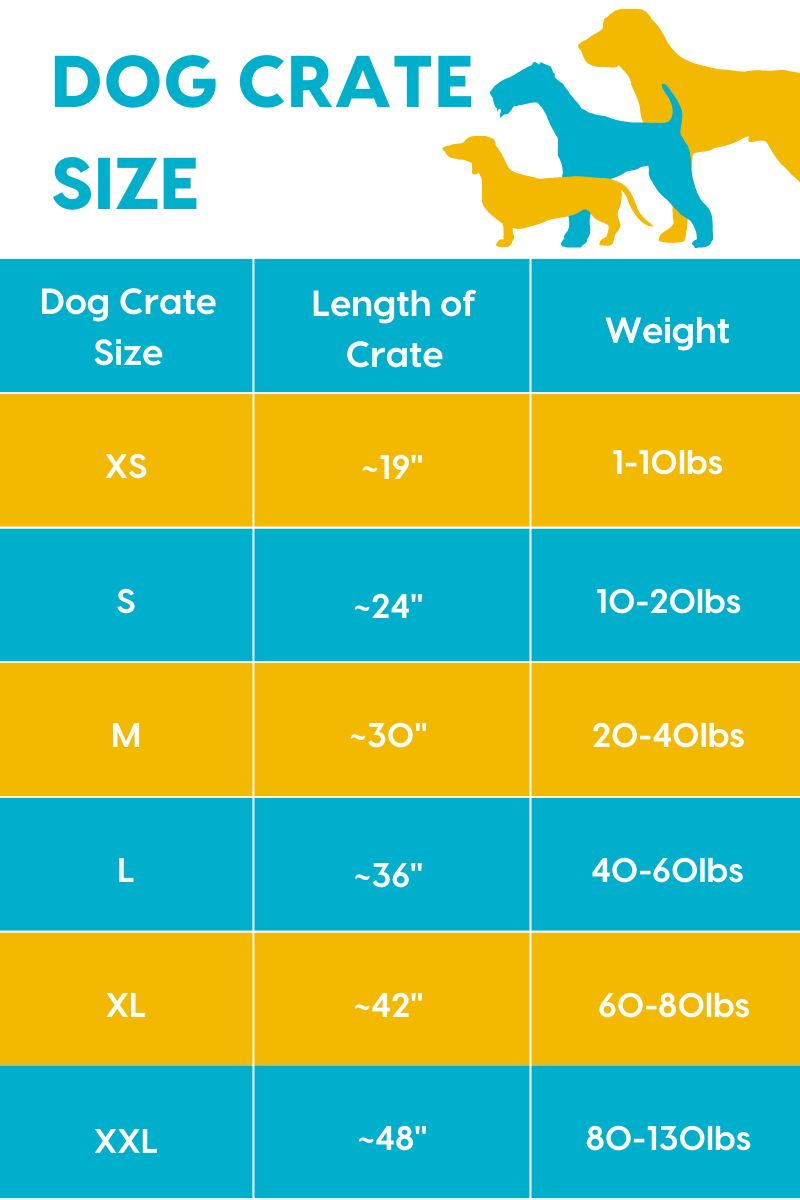A Labrador Retriever typically requires a crate that measures 42 inches long. This size accommodates their height and provides ample space for comfort.
Choosing the right crate size for your Labrador Retriever is essential for their well-being. A well-fitted crate ensures your pet feels secure and relaxed. Labradors are known for their friendly nature and high energy levels, making a comfortable environment crucial.
The right crate not only aids in training but also serves as a safe haven for your dog. Investing in a quality crate can prevent anxiety and destructive behavior when you’re not home. Understanding your dog’s size and behavior will help you select the perfect crate, fostering a positive experience for both you and your furry friend.

Credit: be.chewy.com
Choosing The Right Crate Size For Your Labrador
Choosing the right crate size for your Labrador Retriever is crucial. A crate should provide comfort and security. It should not be too small or too large. The right size helps in training and creates a safe space.
Factors Influencing Crate Size
Several factors influence the crate size you need:
- Age: Puppies grow quickly. Choose a crate that fits their future size.
- Weight: Labradors are typically 55 to 80 pounds. Measure your dog’s weight for accuracy.
- Height: Measure your dog from nose to tail. Consider their standing height.
- Activity Level: Active dogs need more space to move.
General Size Recommendations
Here are general size recommendations for Labrador Retrievers:
| Dog Size | Crate Size |
|---|---|
| Puppy (up to 4 months) | 30 inches (small crate) |
| Adolescent (4-12 months) | 36 inches (medium crate) |
| Adult (1 year and older) | 42 inches (large crate) |
Choose a crate that allows your dog to stand and turn around. A crate that is too big may encourage accidents. A snug fit promotes comfort and security.

Credit: www.petco.com
Types Of Crates And Their Sizes
Choosing the right crate for your Labrador Retriever is essential. Different types of crates offer various benefits. Understanding these options helps you make the best choice.
Wire Crates Vs. Plastic Carriers
Wire crates and plastic carriers serve different needs. Here’s a comparison:
| Feature | Wire Crates | Plastic Carriers |
|---|---|---|
| Ventilation | Excellent airflow | Limited airflow |
| Visibility | High visibility | Low visibility |
| Portability | Less portable | Highly portable |
| Durability | Very durable | Moderately durable |
Wire crates are great for home use. They provide good ventilation and visibility. Plastic carriers are better for travel. They are lightweight and easy to carry.
Adjustable Crates For Growing Labs
Consider adjustable crates for puppies. These crates grow with your Labrador. They have dividers that change size.
- Start small for puppies.
- Expand as your dog grows.
- Save money on future crates.
Look for these features in adjustable crates:
- Secure dividers.
- Easy-to-clean materials.
- Sturdy construction.
Using an adjustable crate helps your pup feel comfortable. It also encourages crate training effectively.
Measuring Your Labrador For A Perfect Fit
Finding the right crate size for your Labrador is crucial. A well-fitted crate ensures comfort and security. Accurate measurements help avoid buying the wrong size. Let’s dive into how to measure your furry friend properly.
Length
To measure the length of your Labrador, follow these steps:
- Have your dog stand on all fours.
- Measure from the tip of the nose to the base of the tail.
This measurement ensures your dog has enough space to lie down. Add 2-4 inches to this length for extra comfort. For most Labradors, a crate length of 36-42 inches works best.
Height
Measuring height is essential for headroom. Here’s how:
- Measure from the ground to the top of the head.
- Ensure your dog stands straight and tall.
For height, add 2-4 inches to this measurement. This extra space allows your dog to stand comfortably. Most Labradors need a crate height of 30-36 inches.
Width Guidelines
Width is also important for comfort. Measure your dog’s width by following these steps:
- Have your Labrador sit or stand.
- Measure across the widest part of the body.
Add 2-4 inches to this width measurement. A width of 24-30 inches is usually appropriate for Labradors.
Comfort And Mobility Considerations
Comfort is key for your dog’s crate experience. Here are some tips:
- Choose a crate that allows your dog to turn around.
- Ensure there is enough space to lie down comfortably.
- Consider a crate with a divider for growing puppies.
Mobility matters too. Your dog should have enough room to stretch. A cramped space can lead to anxiety and discomfort.
A crate that fits well provides a safe haven. Your Labrador will feel relaxed and secure in their space.
Importance Of The Right Crate Size
Choosing the right crate size for your Labrador Retriever is crucial. A properly sized crate ensures safety, comfort, and effective training. A crate that is too small or too large can cause issues.
Safety And Security Aspects
Safety is a top priority for pet owners. An appropriate crate size protects your dog from harm. Here are some key points:
- Prevents Injury: A snug fit reduces the risk of injury.
- Secure Environment: A well-sized crate gives a sense of security.
- Reduces Escape Risks: Proper sizing deters attempts to escape.
If the crate is too large, your Labrador may roam. This could lead to accidents or messes. A correctly sized crate keeps your dog safe.
Impact On Training And Behavior
The right crate size significantly affects training. It helps establish boundaries for your dog. Here are some benefits:
- Promotes Calmness: A snug crate creates a calm atmosphere.
- Encourages Denning Behavior: Dogs naturally seek small spaces.
- Facilitates Housebreaking: A properly sized crate aids in training.
Using the right size encourages positive behavior. Your Labrador learns to associate the crate with safety. Correct sizing can lead to better obedience.
Additional Accessories For Your Lab’s Crate
Creating a comfortable and enjoyable space for your Labrador Retriever in their crate is essential. The right accessories can enhance their experience and make the crate feel like a safe haven. Here are some must-have items to consider.
Bedding And Comfort Items
Providing soft bedding helps your Lab relax and sleep well. Here are some options:
- Crate Pads: Choose a thick, washable pad.
- Blankets: Soft, cozy blankets provide warmth.
- Pillows: Small pillows can add comfort.
Ensure the bedding fits the crate size. Avoid items that can be chewed or swallowed. Regularly clean bedding to maintain hygiene.
Toys And Chewables For Entertainment
Keeping your Labrador entertained is vital. Toys help prevent boredom and anxiety. Consider these types:
| Toy Type | Benefits |
|---|---|
| Chew Toys | Help with dental health and satisfy chewing urges. |
| Interactive Toys | Engage your Lab’s mind and encourage problem-solving. |
| Stuffed Toys | Provide comfort and companionship. |
Rotate toys regularly to keep your Lab interested. Supervise playtime to ensure safety. Remove damaged toys to prevent choking hazards.

Credit: pupford.com
Conclusion
Choosing the right crate size for your Labrador Retriever is essential for their comfort and safety. A well-fitted crate promotes a sense of security and helps with training. Always measure your dog before making a purchase. Investing in the right size crate ensures happy travels and a cozy space at home.
